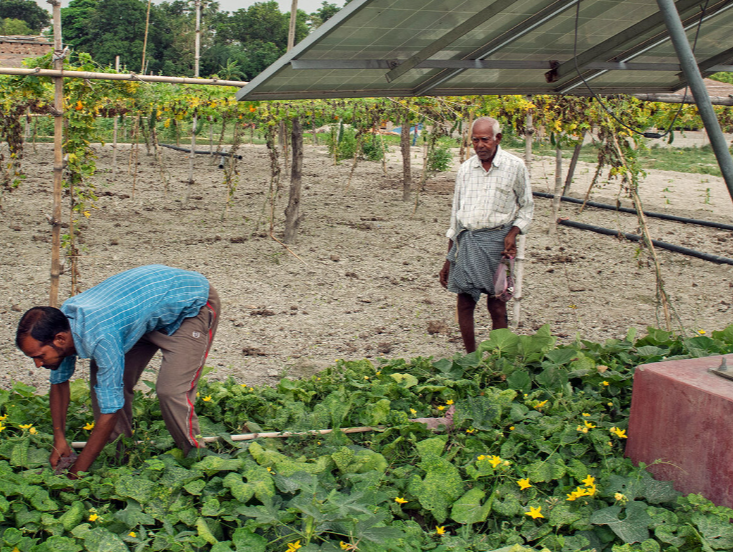
Farmers in Bihar, India, growing crops amidst solar panels. Image by C. de Bode/CGIAR via Flickr (CC BY-NC-SA 2.0).
By Ruth Kamnitzer via MongaBay
The dream of agrivoltaics is to generate your electricity and eat your edamame too. But a recent study in Agroforestry Systems shows that agrivoltaics — growing food beneath solar panels — is not so simple. Research published in September finds that overall crop yields decrease when paired with solar panels and offers a way to standardize agrivoltaic regulations so we don’t give too much valuable agricultural land over to power generation.
“Electricians want more panels, farmers want less,” study author Christian Dupraz, senior scientist in agroforestry and agrivoltaism at the French National Institute for Agriculture, Food and Environment (INRAE), writes in an email to Mongabay. “[The analysis] reveals that maintaining a ‘normal’ agricultural yield under PV [photovoltaic] panels is not possible, even with low GCRs [ground coverage ratios].”
However, planting crops under partial shade isn’t a new idea — and can work under some conditions. Traditionally, agricultural and agroforestry systems used multilayered plantings by, for example, cultivating shade-tolerant crops such as coffee under bananas. Now, with growing demand for clean energy but a paucity of empty land, researchers are exploring how to grow crops under raised solar panels (photovoltaics) instead of trees.
The idea is that the solar panels are arranged so crops still get enough light and may also benefit from protection from extreme weather such as heavy rain, frost or heat. To accomplish this, the solar panels can be arranged above or between crop rows, or in moveable systems that allow more sunlight through at certain times of the day or growing cycle. Some solar panels are even made of semitransparent material. But panels also need to be placed so farmers and farm machinery have enough room to operate. On the other hand, crops can cool the underside of the panels and boost efficiency.
 Strawberries grown under solar panels in the Netherlands. Image courtesy of GroenLeven.
Strawberries grown under solar panels in the Netherlands. Image courtesy of GroenLeven.
Many agrivoltaic trials have reported promising results. For example, a project in southern France found that grapes grown under solar panels needed less irrigation and were of higher quality. A 2019 study in Nature Communications found chile peppers and tomatoes grown under agrivoltaics in Arizona led to higher yields and less drought stress.
And interest is growing. Japan now has more than 3,000 agrivoltaic farms, France has several hundred and, in November 2023, the EU approved a 1.7 billion euro ($1.8 billion) investment in agrivoltaics in Italy.
But Dupraz says caution is needed when extrapolating results to different areas. His study looked at all previous scientific agrivoltaic studies from around the world, using only those that included rigorous control sites. This included trials on lettuce, beans and apples in France; sesame, mung bean and maize in South Korea; kale, broccoli and tomatoes in the U.S.; and more. He found that on the whole, fields with all types of crops yielded less under solar panels compared with control plots.
“Many electricity companies say that pastures love shade,” says Dupraz. “This is not true.”
The study also showed that the ratio of solar panels to land area was a good predictor of crop yields. Even when just a fifth of the ground was covered by solar panels, losses were significant. This also takes into account that some land is taken up by posts, cables and other hardware so can no longer be planted. This is the first time that relationship has been established, says Dupraz, adding that “the impact on policy design is crucial.”
Some countries — notably France, Germany, Italy and Japan — already have regulations that limit how much solar installations on agricultural land are allowed to cut into crop yields. The relationship between the number of solar panels and the yield gives an improved scientific basis for those types of regulations.
 In the Netherlands, raspberries grown under semitransparent solar panels had lower sugar content and yields, says Hellen Elissen, project manager of sustainable energy and biomass at Wageningen University & Research. Image courtesy of GroenLeven.
In the Netherlands, raspberries grown under semitransparent solar panels had lower sugar content and yields, says Hellen Elissen, project manager of sustainable energy and biomass at Wageningen University & Research. Image courtesy of GroenLeven.
Hellen Elissen, project manager of sustainable energy and biomass at Wageningen University & Research, says the study confirms research in the Netherlands.
“What we see is that if you take away the light, your crop yield decreases,” she says. “That doesn’t say that it’s not a viable business case. But it’s not a one-and-one-equals-three business case. It’s always a trade-off between the panels and the crop.”
Elissen says it’s crucial that we understand and work within the limits of the technology. If not, valuable agricultural land could be lost in the pursuit of green energy goals.
Still, there are some situations where agrivoltaics may be advantageous. In the Netherlands, strawberries are typically grown in plastic tunnels to shield them from rain. Wageningen University & Research is experimenting with growing them under solar panels instead, making more intensive use of the land and also reducing plastic waste.
Dupraz says more data on newer technologies like dynamic tracking that can let more light through at critical periods could show that some crops can tolerate higher levels of shade. The study calls for further research on tropical crops such as vanilla, coffee and cacao that are sometimes already grown under shade in agroforestry systems.
The fact that some trials have reported much higher than average yields is exciting and warrants closer investigation, says Carl Bernacchi, professor of integrative biology at the University of Illinois Urbana-Champaign. Bernacchi is part of a multidisciplinary team that will be evaluating agrivoltaics in three different geographic areas in the U.S. as part of the federally funded SCAPES project. Teasing out the influence of crop type, climate, soils, solar installation design and more will show how to “get as much electricity as we can off that land while having absolute minimal impact on the final yield,” he says.
“[Agrivoltaics] has a lot of potential, but it’s not a technology where you can just put a field full of panels … then just throw some crops in between,” Elissen says.
Citations:
Dupraz, C. (2023). Assessment of the ground coverage ratio of agrivoltaic systems as a proxy for potential crop productivity. Agroforestry Systems. doi:10.1007/s10457-023-00906-3
Barron-Gafford, G. A., Pavao-Zuckerman, M. A., Minor, R. L., Sutter, L. F., Barnett-Moreno, I., Blackett, D. T., … & Macknick, J. E. (2019). Agrivoltaics provide mutual benefits across the food–energy–water nexus in drylands. Nature Sustainability, 2(9), 848-855. doi:10.1038/s41893-019-0364-5
To read the original article click here.



 Strawberries grown under solar panels in the Netherlands. Image courtesy of
Strawberries grown under solar panels in the Netherlands. Image courtesy of  In the Netherlands, raspberries grown under semitransparent solar panels had lower sugar content and yields, says Hellen Elissen, project manager of sustainable energy and biomass at Wageningen University & Research. Image courtesy of
In the Netherlands, raspberries grown under semitransparent solar panels had lower sugar content and yields, says Hellen Elissen, project manager of sustainable energy and biomass at Wageningen University & Research. Image courtesy of 






